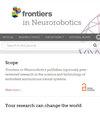The application prospects of robot pose estimation technology: exploring new directions based on YOLOv8-ApexNet
IF 2.6
4区 计算机科学
Q3 COMPUTER SCIENCE, ARTIFICIAL INTELLIGENCE
引用次数: 0
Abstract
IntroductionService robot technology is increasingly gaining prominence in the field of artificial intelligence. However, persistent limitations continue to impede its widespread implementation. In this regard, human motion pose estimation emerges as a crucial challenge necessary for enhancing the perceptual and decision-making capacities of service robots.MethodThis paper introduces a groundbreaking model, YOLOv8-ApexNet, which integrates advanced technologies, including Bidirectional Routing Attention (BRA) and Generalized Feature Pyramid Network (GFPN). BRA facilitates the capture of inter-keypoint correlations within dynamic environments by introducing a bidirectional information propagation mechanism. Furthermore, GFPN adeptly extracts and integrates feature information across different scales, enabling the model to make more precise predictions for targets of various sizes and shapes.ResultsEmpirical research findings reveal significant performance enhancements of the YOLOv8-ApexNet model across the COCO and MPII datasets. Compared to existing methodologies, the model demonstrates pronounced advantages in keypoint localization accuracy and robustness.DiscussionThe significance of this research lies in providing an efficient and accurate solution tailored for the realm of service robotics, effectively mitigating the deficiencies inherent in current approaches. By bolstering the accuracy of perception and decision-making, our endeavors unequivocally endorse the widespread integration of service robots within practical applications.机器人姿态估计技术的应用前景:基于 YOLOv8-ApexNet 的新方向探索
导言服务机器人技术在人工智能领域的地位日益突出。然而,长期存在的局限性仍然阻碍着它的广泛应用。在这方面,人类运动姿态估计是提高服务机器人感知和决策能力所必需的关键挑战。BRA 通过引入双向信息传播机制,有助于捕捉动态环境中关键点之间的相关性。此外,GFPN 还善于提取和整合不同尺度的特征信息,使模型能够对各种尺寸和形状的目标进行更精确的预测。 结果实证研究结果表明,YOLOv8-ApexNet 模型在 COCO 和 MPII 数据集上的性能有了显著提升。与现有方法相比,该模型在关键点定位精度和鲁棒性方面具有明显优势。讨论这项研究的意义在于为服务机器人领域提供了一种高效、准确的定制解决方案,有效缓解了现有方法的固有缺陷。通过提高感知和决策的准确性,我们的努力明确支持了服务机器人在实际应用中的广泛集成。
本文章由计算机程序翻译,如有差异,请以英文原文为准。
求助全文
约1分钟内获得全文
求助全文
来源期刊

Frontiers in Neurorobotics
COMPUTER SCIENCE, ARTIFICIAL INTELLIGENCER-ROBOTICS
CiteScore
5.20
自引率
6.50%
发文量
250
审稿时长
14 weeks
期刊介绍:
Frontiers in Neurorobotics publishes rigorously peer-reviewed research in the science and technology of embodied autonomous neural systems. Specialty Chief Editors Alois C. Knoll and Florian Röhrbein at the Technische Universität München are supported by an outstanding Editorial Board of international experts. This multidisciplinary open-access journal is at the forefront of disseminating and communicating scientific knowledge and impactful discoveries to researchers, academics and the public worldwide.
Neural systems include brain-inspired algorithms (e.g. connectionist networks), computational models of biological neural networks (e.g. artificial spiking neural nets, large-scale simulations of neural microcircuits) and actual biological systems (e.g. in vivo and in vitro neural nets). The focus of the journal is the embodiment of such neural systems in artificial software and hardware devices, machines, robots or any other form of physical actuation. This also includes prosthetic devices, brain machine interfaces, wearable systems, micro-machines, furniture, home appliances, as well as systems for managing micro and macro infrastructures. Frontiers in Neurorobotics also aims to publish radically new tools and methods to study plasticity and development of autonomous self-learning systems that are capable of acquiring knowledge in an open-ended manner. Models complemented with experimental studies revealing self-organizing principles of embodied neural systems are welcome. Our journal also publishes on the micro and macro engineering and mechatronics of robotic devices driven by neural systems, as well as studies on the impact that such systems will have on our daily life.
 求助内容:
求助内容: 应助结果提醒方式:
应助结果提醒方式:


